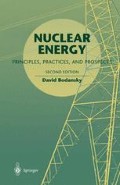Abstract
Prior to the actual discovery of the neutron in 1932, it had long been suspected, in part due to a suggestion by Ernest Rutherford in 1920, that a heavy neutral particle existed as a constituent of the atomic nucleus.1 The discovery of the neutron, as with many of the early discoveries in nuclear physics, was accidental. In the bombardment of beryllium by alpha particles from a naturally radioactive source, a very penetrating radiation had been observed in experiments begun in 1928. In view of its penetrating power, it was first thought to be gamma radiation, but the radiation was found to eject energetic protons from paraffin, which would not have been possible with gamma rays.
Access this chapter
Tax calculation will be finalised at checkout
Purchases are for personal use only
Preview
Unable to display preview. Download preview PDF.
References
Charles Weiner, “1932—Moving Into The New Physics,” in History of Physics, Spencer R. Weart and Melba Phillips, eds. (New York: American Institute of Physics, 1985).
E. Segrè, From X-Rays to Quarks: Modern Physicists and Their Discoveries (San Francisco: W.H. Freeman, 1980).
John A. Wheeler, “Fission in 1939: The Puzzle and the Promise,” Annual Review of Nuclear and Particle Science 39, 1989: xiii–xxviii.
Irving Kaplan, Nuclear Physics (Cambridge, MA: Addison-Wesley, 1954).
Victoria McLane, Charles L. Dunford, and Philip F. Rose, Neutron Cross Section Curves, Volume 2 of Neutron Cross Sections (New York: Academic Press, 1988).
Arthur C. Wahl, “Nuclear-Charge Distribution and Delayed-Neutron Yields for Thermal-Neutron-Induced Fission of 235U, 238U, and 239Pu and for Spontaneous Fission of 252Cf,” Atomic Data and Nuclear Data Tables 39, 1988: 1–156.
E. Segrè, Nuclei and Particles, 2nd edition (Reading, MA: W.A. Benjamin, 1977).
Manson Benedict, Thomas H. Pigford, and Hans Wolfgang Levi, Nuclear Chemical Engineering, 2nd edition (New York: McGraw-Hill, 1981).
James J. Duderstadt and Louis J. Hamilton, Nuclear Reactor Analysis (New York: Wiley, 1976).
John R. Lamarsh, Introduction to Nuclear Engineering, 2nd edition (Reading, MA: Addison-Wesley, 1983).
Ronald Allen Knief, Nuclear Engineering: Theory and Technology of Commercial Nuclear Power, 2nd edition (Washington, DC: Hemisphere Publishing Company, 1992).
Rights and permissions
Copyright information
© 2004 Springer-Verlag New York, LLC
About this chapter
Cite this chapter
(2004). Nuclear Fission. In: Nuclear Energy. Springer, New York, NY. https://doi.org/10.1007/0-387-26931-2_6
Download citation
DOI: https://doi.org/10.1007/0-387-26931-2_6
Publisher Name: Springer, New York, NY
Print ISBN: 978-0-387-20778-0
Online ISBN: 978-0-387-26931-3
eBook Packages: Physics and AstronomyPhysics and Astronomy (R0)

